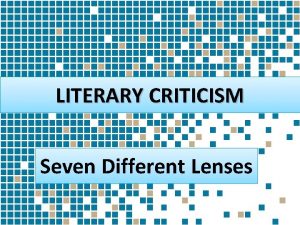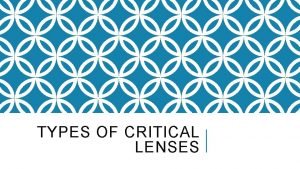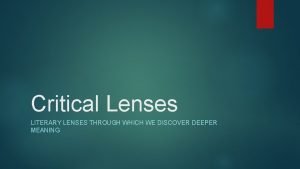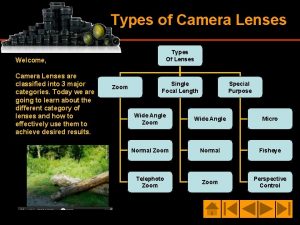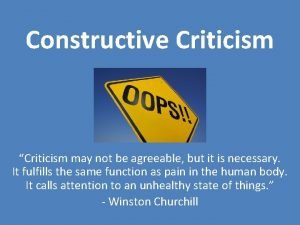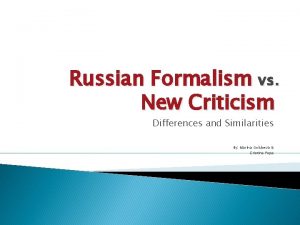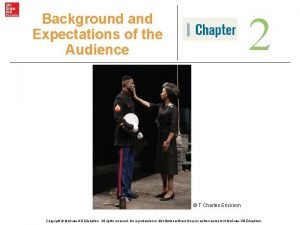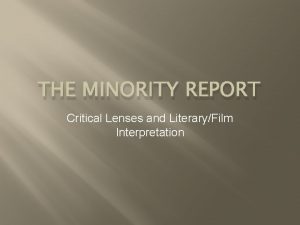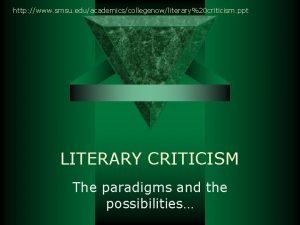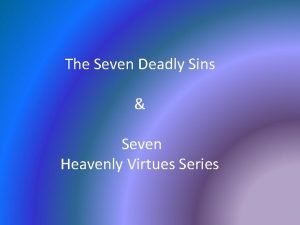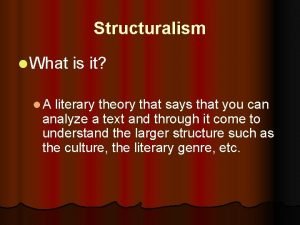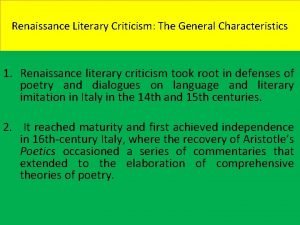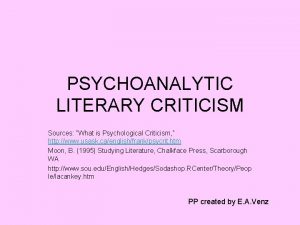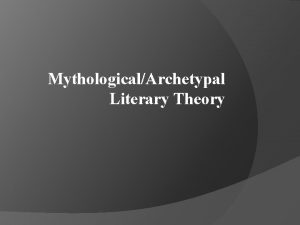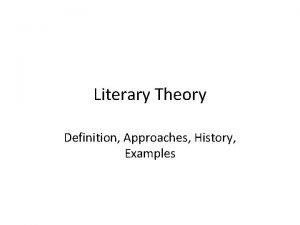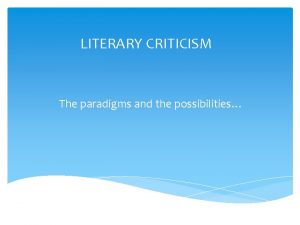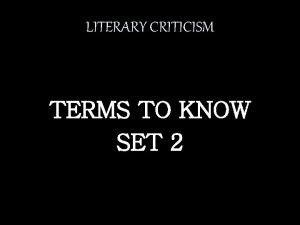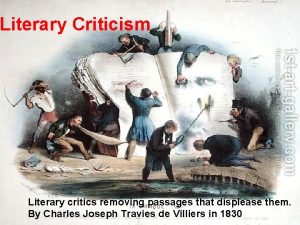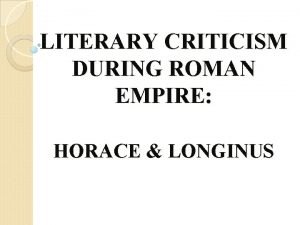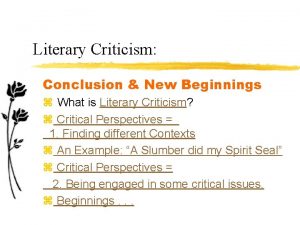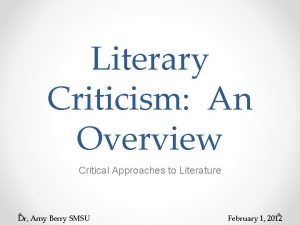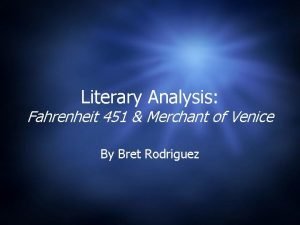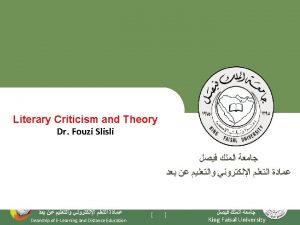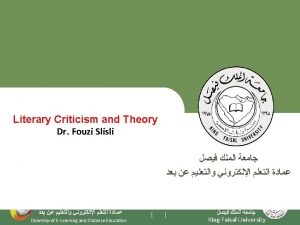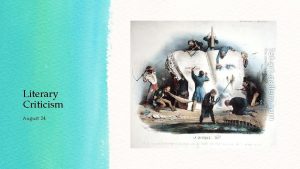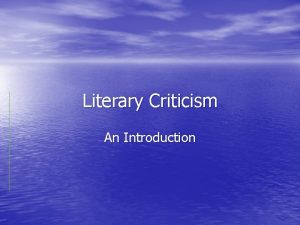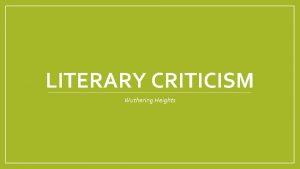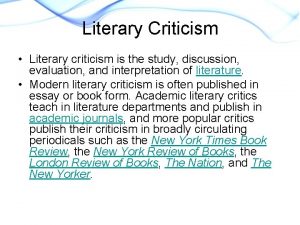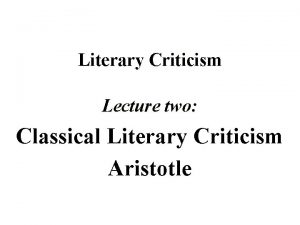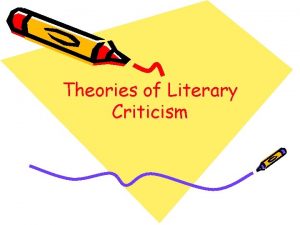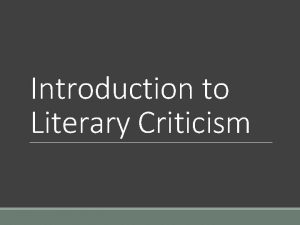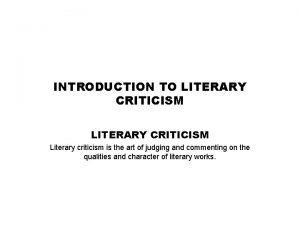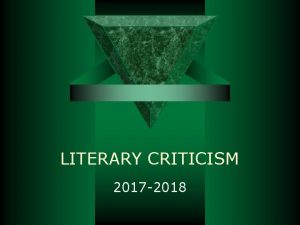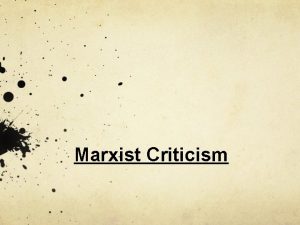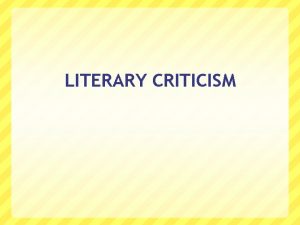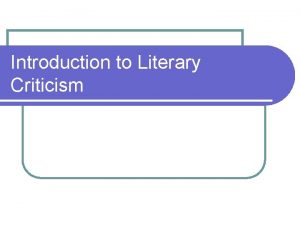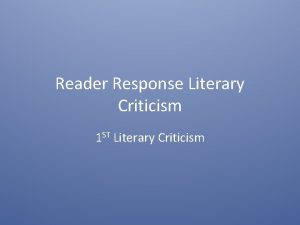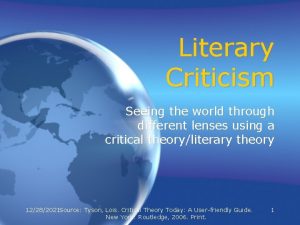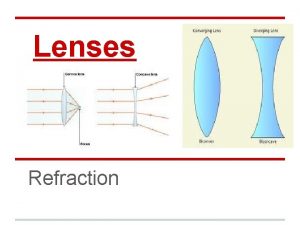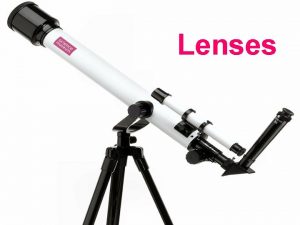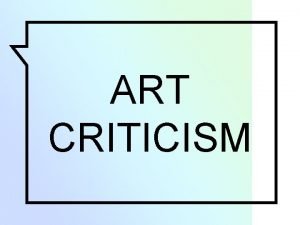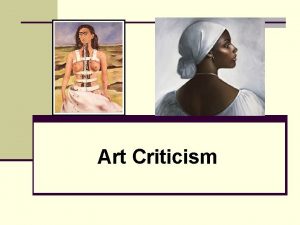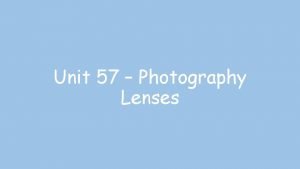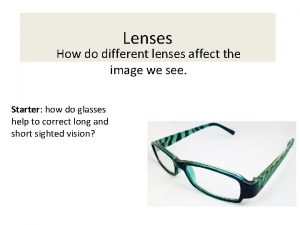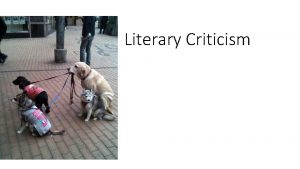LITERARY CRITICISM Seven Different Lenses What is literary


























- Slides: 26

LITERARY CRITICISM Seven Different Lenses

What is literary criticism? Literary criticism are the various lenses you can use to analyze a piece of literature. None is more “right” than any other. They allow the critic to focus on aspects they think are most important to a specific text. 2

SCHOOLS OF LITERARY CRITICISM MARXIST CRITICISM PSYCHOANALYTICAL CRITICISM ARCHETYPAL CRITICISM NEW CRITICISM (FORMALISM) READER-RESPONSE NEW HISTORICISM GENDER CRITICISM

MARXIST CRITICISM • Focuses mainly on social class and political ideologies within a text. • Asks how the text conforms to, contradicts, or challenges societal structures. • Based on the writings and political theories of Karl Marx.

MARXIST CRITICISM Questions that a Marxist Critic might ask: • What role does class play in the work? • How do characters overcome oppression? • In what ways does the work serve as propaganda for the status quo; or does it try to undermine it? • Are social conflicts being ignored?

PSYCHOANALYTICAL CRITICISM • Focuses on the characters and what is going on internally and their motivations. • Can also seek to understand the mind or intentions of the author. • Based on the works of Sigmund Freud (father of Psychology) and Carl Jung (ID, EGO, SUPEREGO).

PSYCHOANALYTICAL CRITICISM Questions that a Psychoanalytical Critic might ask: • Why do characters act or not act on their desires? • In what way is the author expressing their fears about a topic in this novel? • Is the character a reflection of the author’s personality?

ARCHETYPAL CRITICISM • Focuses on cultural archetypes and myths. • Places importance on reoccurring images, symbols and character types (hero, villain, etc).

ARCHETYPAL CRITICISM Questions that a Archetypal Critic might ask: • How is the author using this symbol differently than in older texts? • How does a character contradict the classic image of their archetype? • Does an archetype represent something larger than itself?

NEW CRITICISM • Also called “Formalist” criticism. • Focuses on the literary elements of the text, like metaphor, plot structure, symbolism, etc. • What you most often focus on in English classes. • Does not look at the author, time period, or anything else outside of the text.

NEW CRITICISM Questions that a New Critic might ask: • How does this piece work as literature? • How and why is the author using literary devices? • Why did the author structure the plot a certain way?

READER-RESPONSE • Considers the reader as just as important as the text they are reading. • Explores the effects the text has on the reader. • Texts can be interpreted different ways based on who the reader is.

READER-RESPONSE Questions that a Reader-response Critic might ask: • Why do people from one part of the world like this text more than those from another part? • What is the dominant interpretation of a text and why? • How has my experience with this text changed over the years?

NEW HISTORICISM • Assumes that every piece of literature is a product of its historical time period. • Literature is influenced by the political, social, and cultural climate of that time period. • Also questions how we look back and view that time period as opposed to those who were there.

NEW HISTORICISM Questions that a New Historicism Critic might ask: • How has the interpretation of this text changed over time? • What was this text’s impact on popular culture at the time it was released? • How was the author influenced by the historical time period?

GENDER CRITICISM • Examines how gender roles are reflected or contradicted in a literary text, or how the author’s gender impacts their work. • These critics typically argue that differences in men and women are cultural, not sexual.

GENDER CRITICISM Questions that a Gender Critic might ask: • Would this novel be different if it were written by a man instead of a woman or vice versa? • How do characters defy gender stereotypes? • If a character is L. G. B. T. does it change my interpretation of the text at all?

Same Poem, Different Lense The Red Wheelbarrow How might the different schools of literary criticism interpret William Carlos Williams’ poem “The Red Wheelbarrow”? so much depends upon a red wheel barrow glazed with rain water beside the white chickens.

Same Poem, Different Lense Marxist Criticism: The wheelbarrow represents the working class, and Williams is perhaps calling attention to how much the rest of society -- the chickens -- depends upon their labor. The Red Wheelbarrow so much depends upon a red wheel barrow glazed with rain water beside the white chickens.

Same Poem, Different Lense Psychoanalytical Criticism: In this poem, the poet is not questioning how dependent we are on simple tools, but instead making a desperate case that we are dependent on poetry, which the wheelbarrow represents, thereby revealing his own insecurities. The Red Wheelbarrow so much depends upon a red wheel barrow glazed with rain water beside the white chickens.

Same Poem, Different Lense Archetypal Criticism: The use of water, a universal symbol of life, reinforces Williams’ notion that we depend so much on the agricultural efforts of those who help feed our society, as represented by the raincovered wheelbarrow. The Red Wheelbarrow so much depends upon a red wheel barrow glazed with rain water beside the white chickens.

Same Poem, Different Lense New Criticism (Formalism): Through his use of alternating three-word and one-word lines, Williams is depicting small wheelbarrows, and through them subtly drawing attention to the subject of his poem. The Red Wheelbarrow so much depends upon a red wheel barrow glazed with rain water beside the white chickens.

Same Poem, Different Lense Reader-response: By refusing the give the reader anything more beyond this simple scene, Williams is challenging the reader to question the very notion of what a poem must be. The Red Wheelbarrow so much depends upon a red wheel barrow glazed with rain water beside the white chickens.

Same Poem, Different Lense New Historicism: While contemporary readers of Williams’ poem would have connected strongly to his stark agricultural references, that impact is mostly lost on the digital generation who come across this classic poem for the first time. The Red Wheelbarrow so much depends upon a red wheel barrow glazed with rain water beside the white chickens.

Same Poem, Different Lense Gender Criticism: By drawing a connection of dependency between the wheelbarrow and the chickens, was Williams also making a connection between traditional male roles of the working world and traditional dependent roles of women? The Red Wheelbarrow so much depends upon a red wheel barrow glazed with rain water beside the white chickens.

MARXIST CRITICISM PSYCHOANALYTICAL CRITICISM ARCHETYPAL CRITICISM NEW CRITICISM (FORMALISM) READER-RESPONSE NEW HISTORICISM GENDER CRITICISM
 The analysis of a literary text through various lenses
The analysis of a literary text through various lenses What are the critical lenses
What are the critical lenses Literary critical lenses
Literary critical lenses Marxist critical lens definition
Marxist critical lens definition What are the different types of camera lenses
What are the different types of camera lenses Biblical criticism is not a form of biographical criticism
Biblical criticism is not a form of biographical criticism The difference between criticism and constructive criticism
The difference between criticism and constructive criticism Structuralist/formalist similarities and differences
Structuralist/formalist similarities and differences Descriptive criticism vs prescriptive criticism
Descriptive criticism vs prescriptive criticism What are critical lenses
What are critical lenses Approaches in literary criticism
Approaches in literary criticism The seven heavenly virtues and the seven deadly sins
The seven heavenly virtues and the seven deadly sins Example of structuralism
Example of structuralism Literary criticism in renaissance
Literary criticism in renaissance Definition of psychological criticism
Definition of psychological criticism Mythological literary theory
Mythological literary theory Literary criticism example
Literary criticism example Formalism
Formalism Periods of literary criticism
Periods of literary criticism Archetypal criticism questions
Archetypal criticism questions Decorum horace
Decorum horace Literary criticism conclusion
Literary criticism conclusion Approaches to literary criticism
Approaches to literary criticism Sociological criticism definition
Sociological criticism definition Literary devices in the merchant of venice
Literary devices in the merchant of venice Structuralism literary criticism
Structuralism literary criticism What is post structuralism in literary criticism
What is post structuralism in literary criticism
